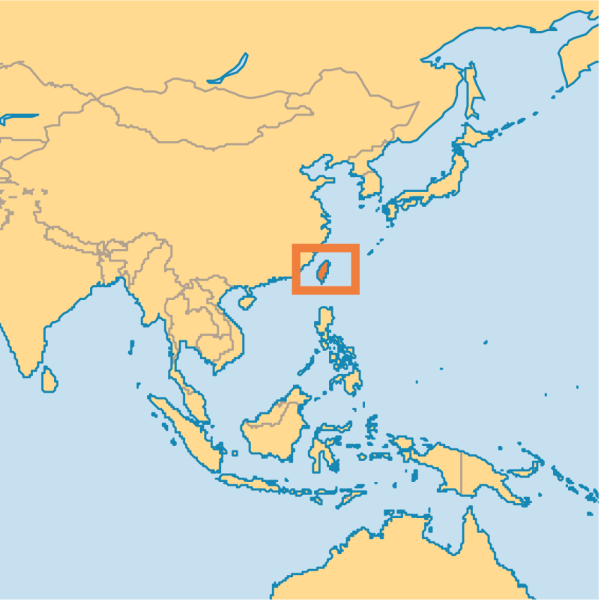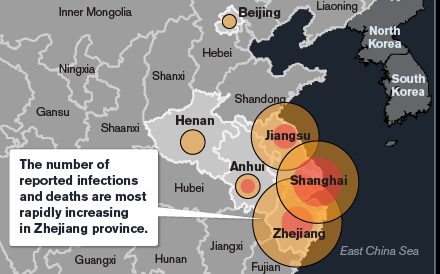Findings
The novel avian influenza A H7N9 virus originated from multiple reassortment events. The HA gene might have originated from avian influenza viruses of duck origin, and the NA gene might have transferred from migratory birds infected with avian influenza viruses along the east Asian flyway. The 6 internal genes of this virus probably originated from 2 different groups of H9N2 avian influenza viruses, which were isolated from chickens. Detailed analyses also showed that ducks and chickens probably acted as the intermediate hosts leading to the emergence of this virulent H7N9 virus. Genotypic and potential phenotypic differences imply that the isolates causing this outbreak form 2 separate subclasses.
Interpretation
The novel avian influenza A H7N9 virus might have evolved from at least 4 origins. Diversity among isolates implies that the H7N9 virus has evolved into at least 2 different lineages. Unknown intermediate hosts involved might be implicated; extensive global surveillance is needed, and domestic-poultry-to-person transmission should be closely watched in the future.
Right…as I said…it’s complicated!
😉

This week CDC announced that suicide deaths have surpassed deaths from motor vehicle crashes in recent years in the United States. Really?? Read that first sentence again and think about it. My next thought is what the heck is going on and where is our safety net?!?!?
In 2010 there were 33,687 deaths from motor vehicle crashes and 38,364 suicides. The CDC Morbidity and Mortality Weekly Report (MMWR) notes that suicide rates among middle-aged Americans have risen substantially since 1999. Wow!
CDC investigated suicide trends among U.S. adults aged 35 to 64 by sex and other demographic characteristics, state of residence, and mechanism of injury from 1999 to 2010, using data available through CDC’s Web-based Injury Statistics Query and Reporting System (WISQARS). Annual suicide rates for this age group increased 28 percent over this period (from 13.7 suicides per 100,000 people in 1999 to 17.6 per 100,000 in 2010), with particularly high increases among non-Hispanic whites and American Indians and /Alaska Natives.
Increases in suicide rates among males and females were also observed from suicides involving hanging/suffocation, poisoning, and firearms. The suicide rates for those aged 10 to 34 and those aged 65 years and older did not change significantly during this period, the report said. Suicide rates among those aged 35 to 64 increased in all states with statistically significant increases occurring in 39 states.
Key findings:
- Suicide rates among those 35 to 64 years old increased 28 percent (32 percent for women, 27 percent for men).
- The greatest increases in suicide rates were among people aged 50 to 54 years (48 percent) and 55 to 59 years (49 percent).
- Among racial/ethnic groups, the greatest increases in suicide rates were among white non-Hispanics (40 percent) and American Indian and Alaska Natives (65 percent).
- Suicide rates increased 23 percent or more across all four major regions of the United States.
- Suicide rates increased 81 percent for hanging/suffocation, compared to 14 percent for firearm and 24 percent for poisoning.
- Firearm and hanging/suffocation were the most common suicide mechanisms for middle-aged men. Poisoning and firearm were the most common mechanisms for middle-aged women.
Most suicide research and prevention efforts have focused historically on youth and the elderly. This report’s findings suggest that efforts should also address the needs of middle-aged persons.
Suicide prevention strategies involve enhancing social support and community connectedness, improving access to mental health and preventive services, and reducing the stigma and barriers associated with seeking help. Other prevention strategies include programs to help those at increased risk of suicide, such as those struggling with financial challenges, job loss, intimate partner problems or violence, stress of caregiving for children and aging parents, substance abuse, and serious or chronic health problems.
The full report is available at http://www.cdc.gov/mmwr.
- CDC’s Injury Center works to prevent violence, injuries, suicide, and their adverse health consequences. For more information about suicide prevention activities and research, visit http://www.cdc.gov/violenceprevention/suicide
- For additional information on the Surgeon General’s National Strategy for Suicide Prevention, go to http://www.surgeongeneral.gov/library/reports/national-strategy-suicide-prevention
- If you or someone you know is experiencing suicidal thoughts, contact the National Suicide Prevention Line at 1-800-273-TALK (8255) and visit online at http://www.suicidepreventionlifeline.org
http://www.cdc.gov/media/releases/2013/p0502-suicide-rates.html
20 Chickens…In A Cooler?!?!?! Really!?!??! From Vietnam! Yikes!
US Customs seized 20 defeathered Chinese Silkies, a white fluffy variety of chicken known for being both great pets and great eating out of a cooler in a Vietnamese passengers luggage. The meat was the color of a bruise, a dark, blueish-gray. In the end, the April 22 incident was a case of no harm, no foul. Customs said the passenger who was stopped may have made an honest mistake and was not deliberately flouting the rules. It does give you a great idea how diseases can be spread in the blink of an eye, or in this case, the transit of a jet from one country to another.
OIE expert mission finds live bird markets play a key role in H7N9 poultry and human infections
ProMed reported on the recent request by China to the the World Organization for Animal Health (OIE) to send OIE experts to assess the H7N9 situation in animals and provide advice. According to the information and data collected, the mission confirms that many of the human cases of H7N9 appear to have a link with live bird markets. To date no human cases or animal infections of H7N9 have been detected on poultry farms. During the mission the team made the hypothesis that people could be infected through exposure to infected birds in markets or to a contaminated environment such as live poultry markets where virus is present.
The OIE statement notes: “H7N9 is genetically a “bird flu”, but one of the ongoing mysteries in the H7N9 outbreak in China is how — with more than 125 people infected — only 46 positive virus samples have been detected out of nearly 70 000 tests conducted on poultry and their environment. Thus far, the virus has not been detected on farms or commercial poultry operations, only in a handful of samples taken from live bird markets.”
The mission also confirms that currently infection with H7N9 does not cause visible disease in poultry therefore veterinary services must be especially involved in preventing its further spread in poultry, particularly through the supervision of the implementation of biosecurity measures on farms.
Trade A Concern
The report went on to note that preventing the national and international spread of the H7N9 virus must be a priority. The strict application by local and national veterinary authorities of member countries of OIE science-based standards published in the OIE Terrestrial Animal Health Code (volume 2; chapter 10.4) can prevent spread of the virus from infected poultry. These standards apply to international trade in live poultry, poultry meat, eggs and even feathers.
The application of these international standards also prevents imposition of unjustified trade barriers by importing countries. Controlling illegal trade must also be a priority.
ProMedMail V2013 #207 http://www.promedmail.org
OIE Press Release: http://tinyurl.com/cltzu6b
Case Count from CIDRAP http://www.cidrap.umn.edu/cidrap/content/influenza/avianflu/news/may0213china.html
CDC issues a new MMWR on #H7N9
Emergence of Avian Influenza A(H7N9) Virus Causing Severe Human Illness — China, February–April 2013
CDC just issued a new Morbidity and Mortality Weekly Report better known as MMWR today on the emerging health risk known to us as H7N9. On March 29, 2013, the China Center for Disease Control and Prevention confirmed three human infections with an avian influenza A(H7N9) virus. The cases, which were reported to the World Health Organization on April 1, occurred among adults (two in Shanghai and one in Anhui Province). All three patients, although not epidemiologically linked, had severe pneumonia, developed acute respiratory distress syndrome, and died from their illness. As of April 29, China had reported 126 confirmed H7N9 cases, including 24 that resulted in deaths. This report summarizes the latest H7N9 findings and recommendations for dealing with potential cases
in the United States.
Since the bird markets were closed in affected cities the numbers have slowed however the disease remains a significant threat. For those of you keeping track we now have a total of 126 cases and 24 deaths reported from 10 provinces in China and Taiwan.
One of the challenging aspects of H7N9 is that infected birds do not appear ill. This means that this could go on for a very long time and in that journey there is a chance for that random mutation that creates a disease transmissible amongst humans. We need to remain alert and stay focused.
http://news.xinhuanet.com/english/video/2013-04/29/c_132348759.htm

All health care for H7N9 is now free in China, for example, to help encourage people to report cases.
What happens next? Who knows!!!! Really, anything is possible. Virus replication is a random act and anything could happen. This includes that it fizzles out, it stays in the background (like the current status of H5N1) or it becomes our next pandemic. No one knows. Max Fisher from the Washington Post, blogged this yesterday and he is spot on! The good, the bad and the ugly!
The Good
1. China is being unusually transparent so far. Ten years ago, as the deadly viral respiratory illness known as SARS first spread across China, the government did not respond well. It suppressed information about the outbreak, making it that much harder to contain and study the disease, ultimately costing lives. This time, though, Chinese authorities have been sharing information about the disease’s spread, and state media appear to be freely reporting on new cases. Chinese officials seem to take the disease seriously and want to combat its rise, even if it means overcoming more secretive instincts. All health care for H7N9 is now free in China, for example, to help encourage people to report cases.
2. The number of cases has largely flatlined in the last week. After weeks of rising cases, the number seems to have stayed stable at around 110 over the last week. Big caveats here that there might be cases we don’t know about, and the count could change at any moment.
3. Shanghai has found some success limiting new cases. A lot of the cases started around Shanghai, but the city was able to reduce the number of new infections after it closed poultry markets, according to Laurie Garrett, a senior fellow at the Council on Foreign Relations covering health-care policy. The Wall Street Journal found the same thing.
The Bad
1. It’s spreading. With cases recently reported in Shandong province and now in Taiwan, the virus seems to be moving outward.
2. No verified human-to-human transmissions, but it’s possible. Neither China nor the World Health Organization has documented human-to-human transmission, which would allow the virus to spread far more quickly and widely, but nor have they ruled it out. The Taiwanese case had no known exposure to poultry.
3. Tough to identify birds with the virus. World Health Organization officials say the virus is more difficult to detect in sick poultry than were previous strains because the birds do not show symptoms that are as clearly identifiable. This makes it tougher to keep sick birds off the market.
The Ugly
1. It’s very deadly, with 18 percent mortality so far. For comparison, tuberculosis has a mortality rate of about 4 or 5 percent in China. Still, the avian flu virus that had its first outbreaks in China in 2006, known as H5N1, has a mortality rate of 60 percent and has killed hundreds of people on multiple continents. It’s way too early to tell H7N9′s mortality rate, given that many infected patients have not yet fully recovered, but it’s so far killed about 18 percent of patients.
2. “This is definitely one of the most lethal influenza viruses that we have seen so far.” That’s according to Keiji Fukuda, the World Health Organization’s assistant director general for health, security and the environment, who added, “This is an unusually dangerous virus for humans.” Fukuda said the WHO is still struggling to understand the disease, but he certainly seems to be sounding the alarm.
3. More easily transmitted than the 2006 avian flu outbreak. That’s also according to the WHO’s Fukuda, who says this new strain is more easily contracted than the H5N1 virus.
Stay tuned, keep watching and don’t fall asleep!
Earthquakes aren’t the only thing that causes the earth to shake! Think explosions and hurricanes too!
Two unrelated events were in the news last week in scientific articles about earth movement better known as earthquakes. Both amazing!

On April 17, an explosion at a fertilizer plant in West, Texas, leveled part of the small town located some 20 miles north of Waco.
One was that the horrific fertilizer plant explosion in West, Texas, which caused at least 14 deaths and left a wide swath of devastation, was so powerful that the United States Geological Survey registered it as a 2.1-magnitude earthquake.

October 29, 2012: Waves crash on shore from high surf ahead of Hurricane Sandy at the pier at Virginia Beach, Virginia. (Rich-Joseph Facun/Reuters)
The seismic impact of Hurricane Sandy last October may have been the same or larger: Keith D. Koper, a geophysicist at the University of Utah, and a colleague reported that waves pounding the seafloor generated “microseisms” that were picked up around the country. “There is no magnitude scale for the microseisms generated by Sandy, but Koper says they range from roughly 2 to 3 on a quake magnitude scale,” ScienceDaily, a news Web site, reported. “The conversion is difficult because earthquakes pack a quick punch, while storms unleash their energy for many hours.”
Makes sense and…Wow!
#H7N9 on the move! Taiwan gets first case. Says it came from China. 108 cases, 22 deaths. WHO Joint Task Force Press Conference

So how did the virus get to China? This is the big question when you aren’t clear on the source of the infection.
Taiwan First Case
Taiwan health authorities confirmed the island’s first human infection of H7N9 avian flu on Wednesday.
A 53-year-old Taiwanese man was confirmed to be infected with the new type of bird flu virus. The patient is believed to have been infected outside Taiwan as he showed symptoms three days after returning from Suzhou City in Jiangsu Province. The patient, who is Hepatitis-B-positive and suffers from high blood pressure, is in a serious condition. A total of 139 people who have had close contact with him are being monitored

I like this map as it gives just a bit of perspective as to where Taiwan is in relationship to everyone else in the region. Who might be next is what we are all thinking?!?!?
Cases – Deaths
As of 24 April 2013 we have 108 cases and 22 deaths.
Joint Press Conference
Here are a few excerpts from the opening statement by Dr Keiji Fukuda, WHO’s Assistant Director-General for Health Security at the joint press conference on the China-WHO Joint Mission on H7N9 Assessment, 24 April 2013:
“First of all, we are impressed with the response by the Government of China. China has responded to this serious outbreak caused by a new influenza virus with strong leadership and a high level of commitment, and sound and effective strategies such as health education, communication and closure of live poultry market.”
“Almost all cases have been sporadic cases, but a few family clusters have been identified. However, we are not sure if the clusters were caused by common exposure to a source of virus or due to limited person to person transmission. Evidence so far is not sufficient to conclude there is person to person transmission. Moreover, no sustained person to person transmission has been found. We want to note that if limited person to person transmission is demonstrated in the future, it will not be surprising. Enhancing surveillance is the way to early detect such occurrence.”
He then made seven recommendations:
- Undertake intense and focused investigations to determine the source(s) of human H7N9 infections with a view to taking urgent action to prevent continuing virus spread and its potentially severe consequences for human and animal health.
- Maintain a high level of alert, preparedness and response for the H7N9 virus even though human cases might drop in the summer, as occurs with many other avian influenza viruses.
- Continue to conduct and strengthen both epidemiological and laboratory-based surveillance in human and animals in all Provinces of China to identify changes that might indicate the virus is spreading geographically and gaining the ability to infect people more easily.
- Ensure that there is frequent two-way sharing of information, close and timely communications and, when appropriate, coordinated or joint investigations and research between ministries of health, agriculture and forestry because this threat requires the combined efforts of these sectors.
- Continue high level scientific collaborations, communications and sharing of sequence data and viruses with WHO and international partners because the threat of H7N9 is also an international shared risk and concern.
- Encourage and foster the scientific and epidemiological studies and research needed to close major gaps in critical knowledge and understanding
- Continue preparedness planning and other IHR core capacity strengthening work because such investments make major differences in being ready to address health security risks and emergencies, including H7N9.
http://news.xinhuanet.com/english/china/2013-04/24/c_132336980.htm
http://www.cnn.com/2013/04/24/world/asia/china-birdflu/index.html
http://www.wpro.who.int/china/mediacentre/speeches/2013/20130424/en/index.html
Massachusetts Governor Deval Patrick and Boston Mayor Tom Menino have announced the formation of The One Fund Boston, Inc. to help the people most affected by the tragic events that occurred in Boston on April 15, 2013.
Many of the wounded could face staggering bills not just for the trauma care they received in the days after the bombings, but for prosthetic limbs, lengthy rehabilitation and the equipment they will need to negotiate daily life with crippling injuries. Even those with health insurance may find that their plan places limits on specific services, like physical therapy or psychological counseling.
Kenneth R. Feinberg, the lawyer who has overseen compensation funds for victims of the Sept. 11 terrorist attacks, the shootings at Virginia Tech and other disasters, arrived in Boston on Monday to start the difficult work of deciding who will be eligible for payouts from a new compensation fund and how much each person wounded in the bombings and family of the dead deserves.
Find out more https://onefundboston.org/pdf/theonefundboston.pdf
To send a check by mail:
One Fund Boston, Inc.
800 Boylston Street #990009
Boston, MA 02199
Send inquiries to: info@onefundboston.org
#H7N9 – 104 cases, 21 deaths. Great Bloomberg graphic. Tough times for bird sellers, great for veggie dealers
Great Bloomberg graphic on # of cases and geographical spread
Click on the link below – great graphic and maps.
Case Count
To date, a total of 104 laboratory-confirmed cases of human infection with avian influenza A(H7N9) virus in China, including 21 deaths have been reported to WHO. Contacts of the confirmed cases are being closely monitored.
http://www.who.int/csr/don/2013_04_22/en/index.html
Loss of business for some is a gain for others!
A new strain of bird flu that has been occurring across parts of China has made poultry dealers really suffer and veggie sales skyrocket!
http://news.xinhuanet.com/english/business/2013-04/22/c_132331068.htm





